Bulletin – June 2017 Global Economy The Chinese Interbank Repo Market
- Download 817KB
Abstract
The market for repurchase agreements (repos) is an important source of short-term funding for financial institutions operating in China. This article outlines the key features of Chinese repo markets, focusing on the interbank market, before discussing recent developments and their impact on the bond market. Repo rates have fallen and become less volatile over the past couple of years, encouraging greater risk-taking in financial markets. Policy settings in China have both shaped and responded to these developments.
Introduction
A repo is an agreement between two parties under which the cash borrower sells or pledges a security (usually a fixed income security) to the cash lender, with the collateral bought back or released from the pledge at a later date. Repos are therefore economically equivalent to secured loans and are an important part of short-term funding markets in many economies.
In China, a repo can be conducted as an exchange-traded transaction on the Shanghai or Shenzhen stock exchanges, or ‘over the counter’ in the interbank market. The exchange-traded market has grown rapidly in recent years. However, the interbank market – in which a range of bank and non-bank financial institutions are active – is much larger (both in terms of turnover and outstanding lending balances) than the exchange-traded repo market or the unsecured interbank lending market (Graph 1 and Graph 2). The interbank repo market is also used by the People's Bank of China (PBC) to adjust domestic liquidity conditions via open market operations. There is around CNY5 trillion (US$720 billion) of lending outstanding in China's interbank repo market, which is around one-third of the size of the US repo market.[1]
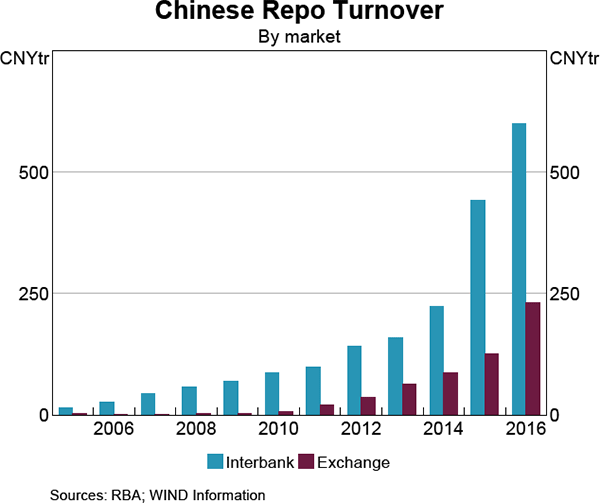
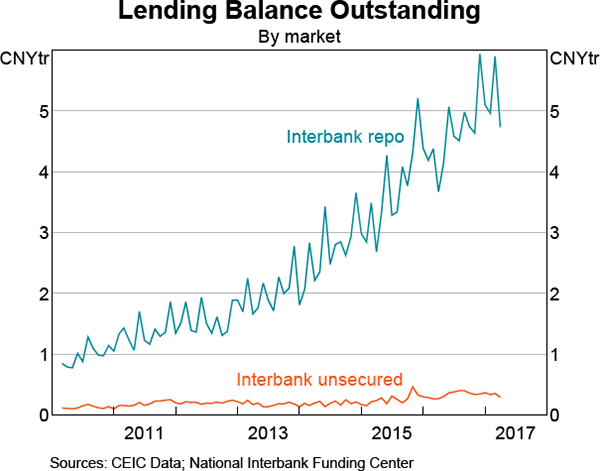
This article focuses on the interbank repo market in light of its systemic importance as a major source of short-term funding, the significant role it plays in the PBC's liquidity management, and the fact that it is viewed by the PBC as an emerging channel for the transmission of monetary policy. We outline the key features of the market through the lens of the major cash lenders and borrowers, and go on to discuss recent developments, focusing on the build-up of risks and changes to the PBC's liquidity management framework.
Ownership of Collateral
As in major repo markets around the world, bonds with low credit risk account for the bulk of collateral used in China's interbank repo market. In recent years, Chinese government bonds together with bonds issued by China's policy banks have accounted for nearly 90 per cent of repo collateral (Graph 3).[2] PBC bills historically accounted for a large share of repo collateral, but their usage has declined as the stock of PBC bills outstanding has fallen over time, reaching zero in 2016. Other instruments (mostly corporate and local government bonds) have accounted for just over 10 per cent of collateral in the interbank repo market over recent years.[3]
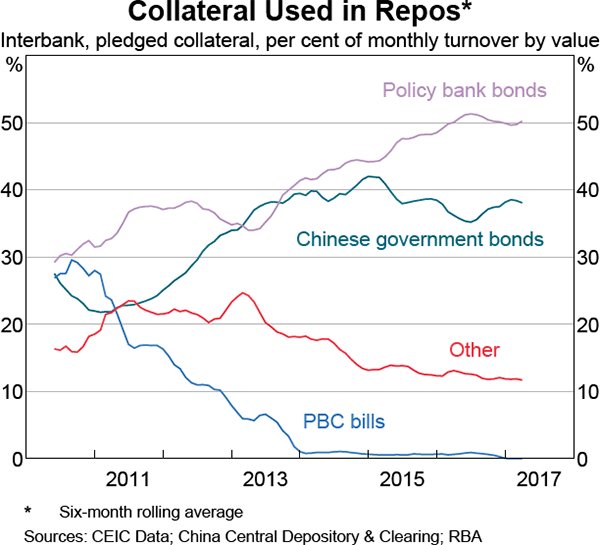
Repos in the Chinese interbank market are generally conducted on a ‘pledged’ basis rather than on an ‘outright’ basis as is common in other major markets (Graph 4). Under an outright repo transaction the ownership of collateral is transferred to the cash lender for the length of the transaction. By contrast, under a pledged repo agreement, ownership of the collateral remains with the cash borrower but is pledged to the lender such that it cannot be used by the borrower for any other purpose until the cash principal and interest is returned.[4],[5]
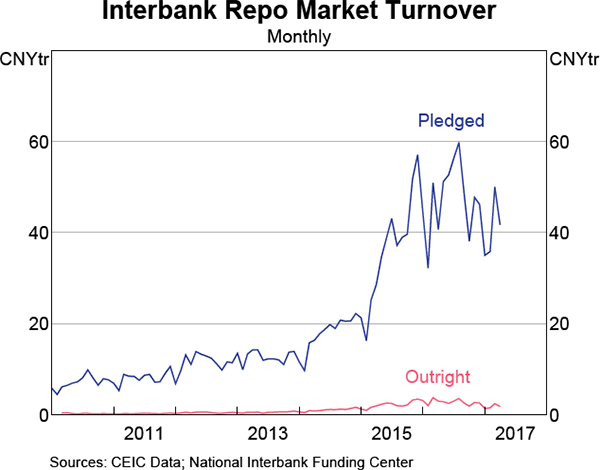
As ownership of the collateral is not transferred to the cash lender in a pledged repo transaction, the lender cannot use (or ‘rehypothecate’) the collateral for the term of the transaction. This has several important implications for the structure of the market in China. First, it precludes the inter-dealer broker model prevalent in other major repo markets. In this model, a dealer acts as an intermediary by lending cash to one counterparty in exchange for collateral, and using that collateral to borrow cash from another counterparty, taking a spread between the two trades as profit. While market participants may act as intermediaries on an opportunistic basis, the process of on-lending funds in the pledged interbank repo market in China requires substantially more collateral than in repo markets where collateral ownership is transferred outright.
Second, pledged repos are less flexible than outright repos. For example, repo markets are commonly used by bond dealers and investors to fund bond positions. This involves purchasing a bond outright and using it as collateral in a repo transaction to borrow the cash needed to fund the bond purchase.[6] Net cash flows are thus zero but the investor gains exposure to the bond. In an outright repo market, the investor can unwind their bond position during the term of the repo by borrowing an equivalent bond under a second repo transaction and selling it outright.[7] This creates a short position that offsets the original long position. However, this is not possible in a pledged repo market as the collateral is not available to be sold. Consequently, in order to retain the ability to exit their positions when desired, bond investors using pledged repo markets to fund their positions are likely to have a preference to borrow cash for shorter terms relative to equivalent investors funding their positions through outright repo markets. Indeed, in the case of China, the use of overnight repos in the pledged repo market increased dramatically during 2015 alongside an increase in the bond-repo carry trade (discussed below).
Finally, if market participants cannot rehypothecate collateral, they have less scope to profit from interest rate differentials. This may go part of the way to explaining the steep slope of the Chinese repo curve, particularly the spread between overnight and 7-day repo rates, which is persistently large (Graph 5). In an outright repo market, participants could take advantage of an interest rate differential such as this by lending cash at the 7-day rate and using the collateral received to borrow at the lower overnight rate. In a pledged repo market, these market participants would need to post their own collateral, increasing the cost of the trade.
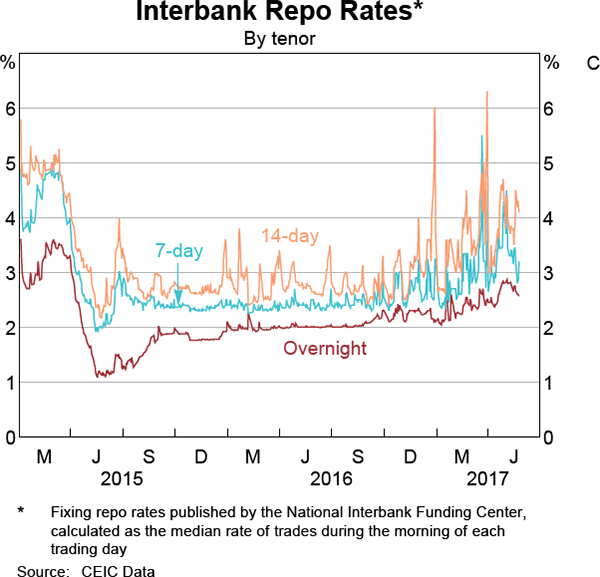
Cash Lenders in the Interbank Repo Market
Large Chinese commercial banks have historically been the major suppliers of cash in the interbank pledged repo market (Graph 6). In particular, the large state-owned commercial banks account for a substantial share of lending. This reflects their large retail deposit bases and relatively conservative balance sheet management, which have resulted in more funds being available to lend in the repo market.[8]
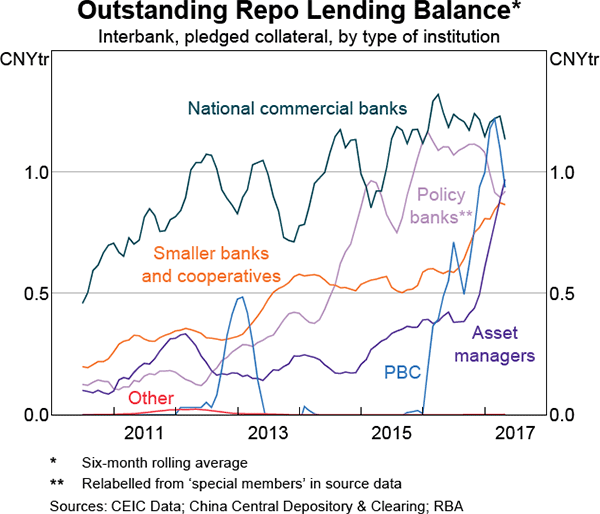
In contrast with the large national banks, while smaller banks (referred to as city commercial and rural commercial banks in China) are responsible for a substantial share of lending in the repo market, they have been net borrowers overall. The scale of these institutions' involvement in both the borrowing and the lending sides of the market may be indicative of on-lending activity, whereby institutions take advantage of opportunities to borrow cash at a lower rate than that at which they can lend. However, it is also likely to reflect differences in repo market activity between institutions within this group.
Another significant source of funds in the interbank repo market is China's policy banks.[9] Policy banks' lending in the repo market has increased rapidly since early 2014, tripling in the space of two years and making them systemically important participants in the market. A large increase in policy banks' funding over recent years, via both bond issuance (the traditional funding source for policy banks) and the PBC's Pledged Supplementary Lending Facility (a facility launched in 2014 that provides low-cost funding to policy banks to support development lending), has contributed to an increase in their capacity to lend. It is possible that policy banks' increased repo activity could have been part of a state-led push to reduce volatility in repo rates (discussed below).
The PBC's lending in the interbank pledged repo market, via its open market operations, has also increased rapidly over the past couple of years.[10] This reflects the PBC's preference to manage liquidity conditions through more active use of open market operations rather than through changes to reserve requirement ratios, as well as the decline in the PBC's foreign currency reserves since 2014, which has required offsetting liquidity injections. Like policy bank activity, this increase in the PBC's activity in the repo market is likely to be aimed at reducing the volatility of repo rates.
Asset managers use the repo market for liquidity management purposes, and have increased their share of lending over recent years as the value of assets under management has grown.[11] However, their cash lending in the interbank repo market is considerably smaller than their borrowing.
Cash Borrowers in the Interbank Repo Market
Smaller banks and asset managers account for most of the borrowing in the interbank pledged repo market, with smaller banks accounting for around half of outstanding borrowing (Graph 7). These banks have smaller retail deposit bases than the large state-owned commercial banks, and as a group have been expanding their balance sheets rapidly over recent years, resulting in an increased reliance on wholesale funding such as repo (RBA 2016).
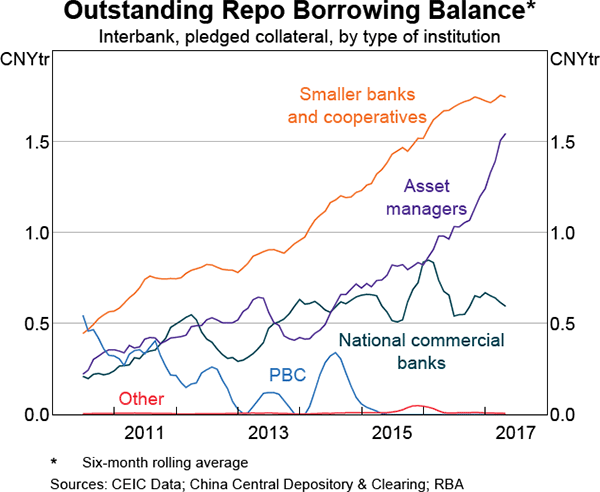
In recent years, asset managers have also increased their borrowing in the interbank pledged repo market, and now account for a significant share of outstanding borrowing. This increase has occurred alongside a sharp increase in the value of these funds' assets under management, partly reflecting the generally less restrictive regulation of some types of funds management companies compared with banks' activities. Asset managers are likely to have increased their borrowing in the repo market in recent years in order to engage in the bond carry trade (discussed below).
The borrowing by national commercial banks includes borrowing by joint-stock banks (which are smaller than the large state-owned banks that are major suppliers of funds), as well as by the large state-owned banks for the purpose of on-lending. The interest rates on repo agreements in the interbank market are differentiated based on both the quality of collateral offered and the perceived creditworthiness of the borrower (Shevlin and Chang 2015).[12] Larger state-owned banks are perceived as having the highest credit quality, and so borrow at lower rates than smaller banks, while asset managers typically borrow at higher rates than the smaller banks. Higher rated institutions such as the national commercial banks can therefore borrow at relatively low rates and on-lend at higher rates to smaller (less creditworthy) institutions for profit.
Graph 8 shows net lending in the pledged interbank repo market by type of institution. This measure abstracts from on-lending activities and differences within groups and thus shows the ultimate suppliers and users of funds. In net terms, the policy banks and the PBC are larger suppliers of funds than the national commercial banks, while smaller banks and asset managers are net borrowers.
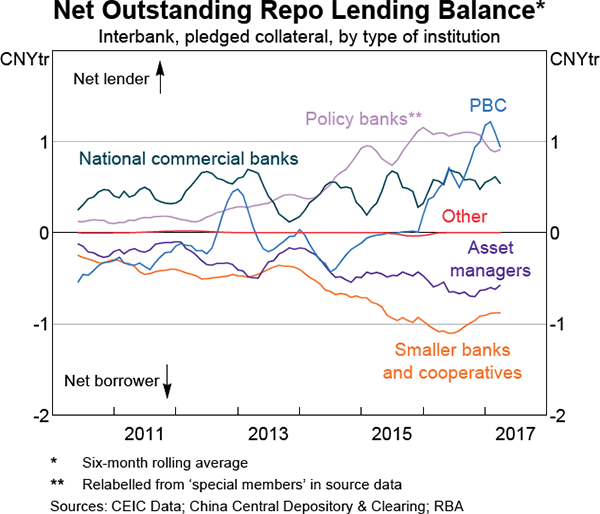
Recent Developments and Their Implications
In recent years an apparent policy-induced decline in the level and volatility of repo rates has been followed by an increase in leveraged bond investments funded via repo, with an associated build-up of risks in both formal and informal markets. The PBC has responded with measures to discourage excessive risk-taking, including by extending the term of open market operations and allowing short-term interest rates to increase and become more volatile.
The reduction in the volatility of repo rates
The volatility of Chinese repo rates declined significantly over 2015 and has generally remained low since then, notwithstanding an increase since the second half of 2016 (Graph 9). One factor contributing to lower volatility was the introduction of reserve averaging for banks in September 2015 (IMF 2016).[13] However, the increased involvement of policy banks and the PBC in the repo market suggests a broader policy objective by the Chinese authorities to dampen volatility. A working paper co-authored by the chief economist of the PBC's research bureau in early 2016 supports this assessment (Ma et al 2016). Specifically, it recommends shifting monetary policy from the current approach (focused on quantitative lending targets, ‘window guidance’ and central guidance of benchmark lending and deposit rates) towards an interest rate corridor approach – a shift that has also been encouraged by the International Monetary Fund (IMF 2016). The working paper also emphasises the importance of improving the transmission from short-term rates (particularly the 7-day repo rate) to other rates in the economy. A February 2017 article from PBC Assistant Governor Zhang Xiaohui reiterates these goals. It states that the transmission from short-term rates (especially the 7-day repo rate and the rates on the PBC's Medium-term Lending Facility) to bond rates and bank loan rates has improved (Zhang 2017).
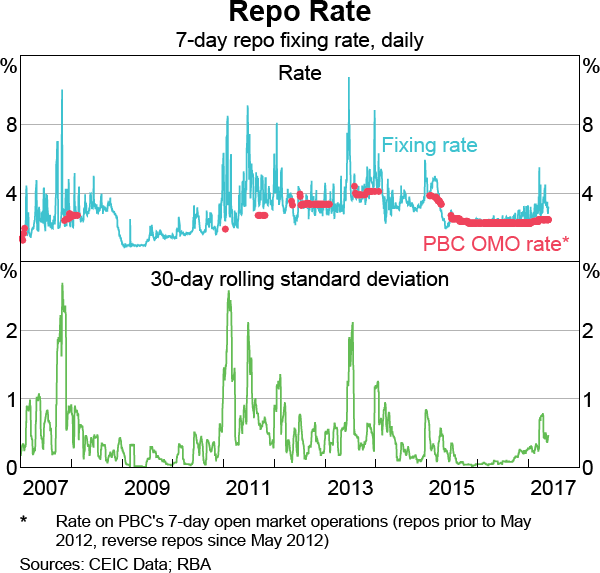
Policy banks increased their lending in the interbank pledged repo market from early 2014, with their share of outstanding loans rising from around 20 per cent to almost 40 per cent by early 2015 (Graph 10). In early 2016, the share of policy and central bank lending grew further as the PBC increased its activity in the repo market. At the same time, the PBC started managing liquidity more actively, increasing the size of injections and withdrawals and moving from bi-weekly open market operations to daily open market operations (Graph 11). This enabled the PBC, like other central banks, to mitigate short-term fluctuations in liquidity conditions more effectively, such as those arising from large tax payments or seasonal demand for cash.

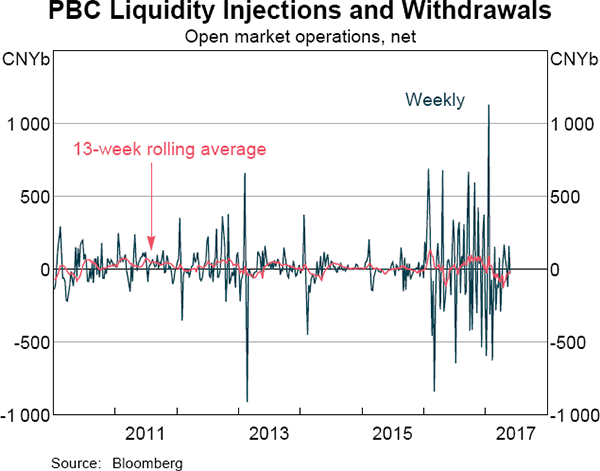
The bond carry trade
The structural decline in the volatility of repo rates has given rise to a consistent spread between yields on short-term repos and long-term bonds. This spread facilitates the bond ‘carry trade’, a leveraged bond investment in which the investor receives the higher long-term interest rate, but pays the lower shorter-term rate (that is, the investor buys a bond and pledges it in exchange for cash through the repo market). Reports suggest that the combination of the low level and low volatility of repo rates has indeed led to an increase in leveraged bond investments (Bloomberg 2016; Dongming 2016; Xinhua Finance Agency 2016), and PBC commentary has noted risks to financial institutions related to maturity mismatch (Zhang 2017).
In the case of investments in long-term bonds funded via short-term repo, the trade is subject to refinancing risk whereby the interest differential earned on the trade is eroded or becomes negative if repo rates increase. The carry trade is also subject to the risk of capital losses. This risk is magnified by the leveraged nature of the investment, with the result that investors funding positions through the repo market are highly sensitive to moves in bond yields.
The widest and most consistent spread has been between overnight repo and long-term bonds (Graph 12). This has likely contributed to the sharp increase in overnight repo turnover that occurred from early 2015 alongside growth in repo borrowing by smaller banks and asset managers (Graph 13). On the investment side, liquidity as measured by bid-ask spreads improved steadily over the same period, with the carry trade increasing bond trading volumes in an environment of low and stable interest rates. However, to the extent that bond market liquidity is supported by the carry trade it can be expected to deteriorate quickly when interest rates rise. There was some evidence of this in the December quarter of 2016, when bid-ask spreads widened alongside increases in repo market volatility and bond yields. More generally, the build-up in leveraged bond investments appears to have increased the sensitivity of the bond market to volatility in repo rates. For example, in 2013 large increases in repo rates had little impact on the bond market, while a relatively minor pick-up in the level and volatility of repo rates in late 2016 contributed to a material increase in yields.
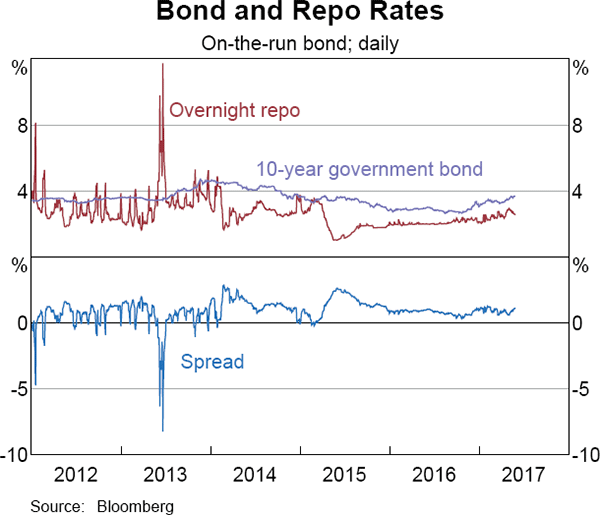
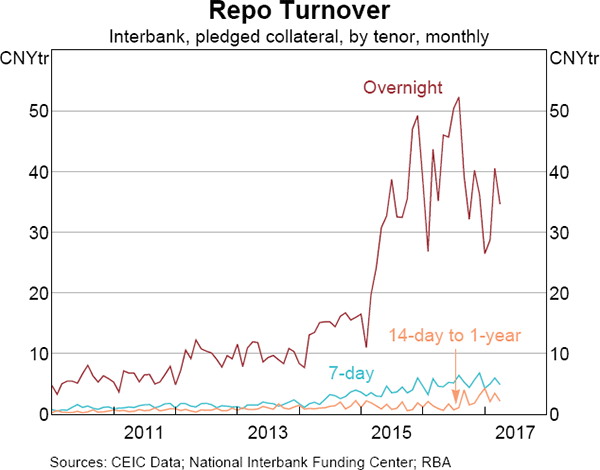
Part of the pick-up in the level and volatility of repo rates over the second half of 2016 has reflected the increased share of borrowing by asset managers over this period (in addition to changes to the PBC's liquidity operations, discussed below). On average, asset managers are likely to borrow at a higher rate than banks (reflecting higher perceived credit risk, Shevlin and Chang (2015)), contributing to a rise in average repo rates as these institutions' share of turnover increases. Asset manager activity also contributes to higher volatility to the extent that the rates at which these institutions can borrow are more sensitive to changes in credit risk appetite. In December 2016, repo rates rose substantially as the premium paid by asset managers to borrow relative to banks increased sharply. This premium rose in response to concerns regarding the use of informal repo agreements known as ‘dai chi’ by some interbank repo market participants.
The dai chi market
Dai chi (which translates as holding something on someone's behalf) is the practice of selling a bond in exchange for cash, and buying back the bond later at a price and date agreed at the start of the trade. Dai chi agreements are economically equivalent to a repo agreement, but do not take place via the interbank or exchange-traded markets and are often informal in nature.[14] For example, dai chi agreements have reportedly been struck using instant messaging services. Due to this informality, some transactions undertaken in this market may not be legally enforceable.
There are several reasons that market participants may elect to transact in the dai chi market instead of in formal repo markets. Dai chi transactions can be used to remove assets from balance sheets for the period of the loan, circumventing regulatory limits on leverage. Dai chi also allows collateral to be rehypothecated, facilitating greater flexibility and leverage than pledged repo.
Though few data are available on this informal market, the practice is reportedly widespread. The president of CCDC has estimated that the value of dai chi outstanding may be as high as CNY12 trillion (US$1.7 trillion), which would make it twice as large as the interbank repo market (Dong 2016; Hong 2017). Without knowing the types of collateral used, the enforceability of contracts or the creditworthiness of the institutions involved, it is difficult to make an assessment of the risks involved with this activity. However, the informality of the dai chi market suggests that risks are likely to be higher than in the formal repo market. Moreover, there is likely to be some degree of overlap between participants in the formal and informal repo markets, such that risks that manifest in the dai chi market could spill over into the interbank and exchange-traded markets.
In mid December 2016 the asset management firm Sealand Securities announced that two former directors had forged CNY16.5 billion (US$2.4 billion) in dai chi contracts in transactions with a number of other financial institutions. Sealand's announcement cast doubt over whether the firm would buy back the bonds being held in relation to the fraudulent transactions, which at the time were carrying mark-to-market losses of around CNY1 billion (US$145 million), or 7 per cent of the firm's shareholder equity.
The announcement resulted in volatility in interest rate markets. In the formal repo market, cash lenders became reluctant to provide funding to non-bank financial institutions, with the spread between interest rates paid by these institutions and those paid by banks increasing sharply.[15] In the bond market, yields rose significantly and bid-ask spreads widened. However, this dislocation was short lived as the China Securities Regulatory Commission was reported to have stepped in to force a resolution and large Chinese banks reportedly increased their lending in the repo market via ‘X-repo’. X-repo is a repo facility launched by the PBC in 2015 to anonymously match interbank repo lenders and borrowers, with standardised collateral and haircut requirements. Lending through X-repo ensured access to financing for non-bank financial institutions that were unable to borrow via traditional repos due to the spillover of credit concerns from the dai chi market into the interbank market.
Extension to the term of the PBC's market operations
The increased use of leveraged bond purchases and informal repo markets has increased the level of risk in China's financial system. In August 2016, in an apparent response to these risks, the PBC started augmenting its standard 7-day open market operations with 14- and 28-day terms. While there was no official comment on the change in approach at the time, there were widespread reports (Reuters 2016) that the PBC was trying to reduce the extent of leveraged bond purchases by encouraging less use of overnight repos and greater use of (more expensive) longer-term repos.
In February, PBC Assistant Governor Zhang noted that the change to the PBC's open market operations had the practical effect of mitigating financial institutions' maturity mismatch and liquidity risks (Zhang 2017). Overnight repo turnover has fallen since the change, with some investors in the bond carry trade likely to have been deterred by the resulting increase in the level and volatility of repo rates.
Conclusion
Chinese repo markets have expanded rapidly in recent years, consistent with the broader development of China's financial markets. This growth has provided financial market participants with the depth and liquidity necessary to effectively manage their short-term assets and liabilities. Moreover, the repo market's development is viewed by the PBC as supporting further moves toward a monetary policy framework based on targeting a short-term interest rate in the future. However, as in other financial markets, the expansion of short-term funding markets can give rise to financial stability risks, especially where these markets are informal in nature. Risks appear to have risen with the growth in China's repo markets, and the policy landscape is responding to these risks.
Footnotes
The authors are from International Department. [*]
The size of the US repo market is slightly over US$2 trillion, based on 2016 data on repos outstanding from the Federal Reserve Bank of New York Primary Dealer Statistics database. [1]
Policy banks are state-owned financial institutions that play a quasi-fiscal role in channelling government funding to infrastructure and development projects, and also play a significant role in the financial system. [2]
In the pledged interbank market, collateral must meet the requirements specified by the cash lender, but is otherwise generic. That is, cash lenders are not able to request specific or ‘special’ securities as collateral as is the case in most major markets. Collateral requirements commonly relate to issuer type, credit rating, tenor and or other structural features of the bond (for example, callable bonds are not accepted as collateral by many lenders). [3]
Outside of China, repo may also be conducted on a ‘pledged for re-use’ basis, which allows the cash lender to rehypothecate the collateral even though there is no transfer of title. [4]
China Central Depository & Clearing (CCDC), a state-owned entity responsible for the registration, custody and settlement of most fixed-income securities in China, is responsible for ensuring that the pledged securities it holds are not used for any other purpose, including being pledged as collateral to another repo, until the transaction has been unwound. [5]
As transactions do not settle instantaneously, funding may be acquired after the purchase of a bond. [6]
In most major markets dealers may also exit a bond position by substituting collateral, or they may use open-ended repos in which the date of the second leg is not specified at the commencement of the transaction. These approaches are not possible in the pledged interbank market. [7]
CCDC data on repo activity by ‘national commercial banks’ cannot be split further between the large state-owned commercial banks and the smaller ‘joint-stock banks’. However, data on the source and use of funds in the domestic banking system from the PBC suggest that the four large state-owned commercial banks account for the vast majority of repo lending by this category of banks. [8]
Policy banks' activity is recorded in the ‘special members’ category (Cruz, Gao and Song 2014). Of the three policy banks, China Development Bank (CDB) is the most active in the repo market, with net lending by ‘special members’ in the pledged repo market closely aligning with figures on repo lending recorded on CDB's balance sheet. [9]
PBC repo lending and borrowing figures are calculated from PBC open market operations. Lending to or borrowing from the PBC is not captured in the data for other institutions, or in the aggregate turnover or balances data. [10]
For the purpose of this article, we group together institutions recorded as fund institutions, insurance institutions, securities companies and non-bank financial institutions as asset managers. [11]
All else being equal, the credit quality of the borrower should matter more under a pledged repo system, to the extent that it is more difficult for the lender to acquire the collateral that has been pledged in the event of a default. The only reported instance of default in China's interbank repo market that we are aware of involved the failure to repay an overnight repo of less than CNY50 million (US$7 million) in March 2017 (Bloomberg 2017). This reported default has not been officially confirmed. [12]
The rule change allows banks to report a required reserve ratio up to 1 per cent lower than the compulsory ratio set by the PBC on any given day, as long as they meet the requirement on average during an assessed period. [13]
The information on the dai chi market is based on Dong (2016), Moriyasu (2016), BIS (2017), Hong (2017) and Long (2017). [14]
The gap between a measure of the 7-day repo rates that includes borrowing by all types of financial institutions and one that includes only borrowing by deposit-taking institutions spiked to around 100 basis points in late December from a normal range of around 10 to 30 basis points. [15]
References
BIS (Bank for International Settlements) (2017), ‘Box B: From Wealth Management Products to the Bond Market’, BIS Quarterly Review, March.
Bloomberg (2016), ‘China's $1 Trillion Bond Leverage Unwinds as Pimco Senses Panic’, bloomberg.com site, 28 April, viewed 23 May 2017. Available at <https://www.bloomberg.com/news/articles/2016-04-27/china-s-1-trillion-bond-leverage-unwinds-as-pimco-senses-panic>.
Bloomberg (2017), ‘PBOC Said to Inject Funds After Missed Interbank Payments’, bloomberg.com site, 21 March, viewed 23 May 2017. Available at <https://www.bloomberg.com/news/articles/2017-03-21/pboc-said-to-inject-liquidity-after-interbank-payments-missed-j0jejifd>.
Cruz PC, Y Gao and LL Song (2014), ‘The People's Republic of China's Financial Markets: Are They Deep and Liquid Enough for Renminbi Internationalization?’, Asian Development Bank Institute Working Paper Series 477.
Dong J (2016), (Scale of Dai Chi Market Estimated at RMB12 Trillion, Changes Proposed to Improve Repo Market), caixin.com site, 27 December, viewed 23 May 2017. Available at <http://finance.caixin.com/2016-12-27/101030995.html>.
Dongming TX (2016), ‘The Cause of the Current Bond Market Turmoil?’, OCBC Bank China Insights, 19 December, viewed 23 May 2017. Available at <https://www.ocbc.com/assets/pdf/regional%20focus/china/china%20insights/2016/china%20insights%2019122016.pdf>.
Hong S (2017), ‘Behind China's Bond Selloff, a Risky Twist on the Repo Trade’, The Wall Street Journal Online, 17 January, viewed 23 May 2017. Available at <https://www.wsj.com/articles/behind-chinas-bond-selloff-a-risky-twist-on-the-repo-trade-1484654059>.
IMF (International Monetary Fund) (2016), ‘The People's Republic of China: Selected Issues’, IMF Country Report No 16/271.
Long C (2017), ‘Dodging a Bullet in the Interbank Market’, Gavekal Dragonomics China Ideas, 19 January.
Ma J, H Hong, Y Jia, S Zhang, LH Yin and G An (2016), ‘The Role of Yield Curves in Monetary Policy Transmission’, People's Bank of China Working Paper No 2016/1.
Moriyasu K (2016), ‘China Bonds the Latest Bubble to Pop’, Nikkei Asian Review, asia.nikkei.com site, 22 December, viewed 23 May 2017. Available at <http://asia.nikkei.com/Markets/Capital-Markets/China-bonds-the-latest-bubble-to-pop?page=1>.
RBA (Reserve Bank of Australia) (2016), ‘Box A: Recent Growth of Small and Medium-sized Chinese Banks’, Financial Stability Review, October, pp 14–16.
Reuters (2016), ‘China Central Bank Urges Banks to Spread Out Tenors of Loans: Sources’, reuters.com site, 25 August, viewed 23 May 2017. Available at <http://www.reuters.com/article/us-china-economy-centralbank-liquidity-idUSKCN110065?il=0>.
Shevlin A and A Chang (2015), ‘China's Repo Markets: The Structure and Safeguards of China's Largest, Most Liquid Money Market Instrurments’, J.P. Morgan Liquidity Insights, viewed 23 May 2017. Available at <https://am.jpmorgan.com/au/en/asset-management/gim/liq/liquidity-insights/chinas-repo-markets>.
Xinhua Finance Agency (2016), ‘Regulators Survey Risk of RMB5 Trln Leverage Fund in Bond Market’, xfafinance.com site, 21 April, viewed 23 May 2017. Available at <http://en.xfafinance.com/html/In_depth/2016/216356.shtml>.
Zhang X (2017), (Review and Prospect of Monetary Policy), China Finance, No 3, 3 February. Republished on business.sohu.com site, viewed 23 May 2017. Available at <http://business.sohu.com/20170203/n479832292.shtml>.